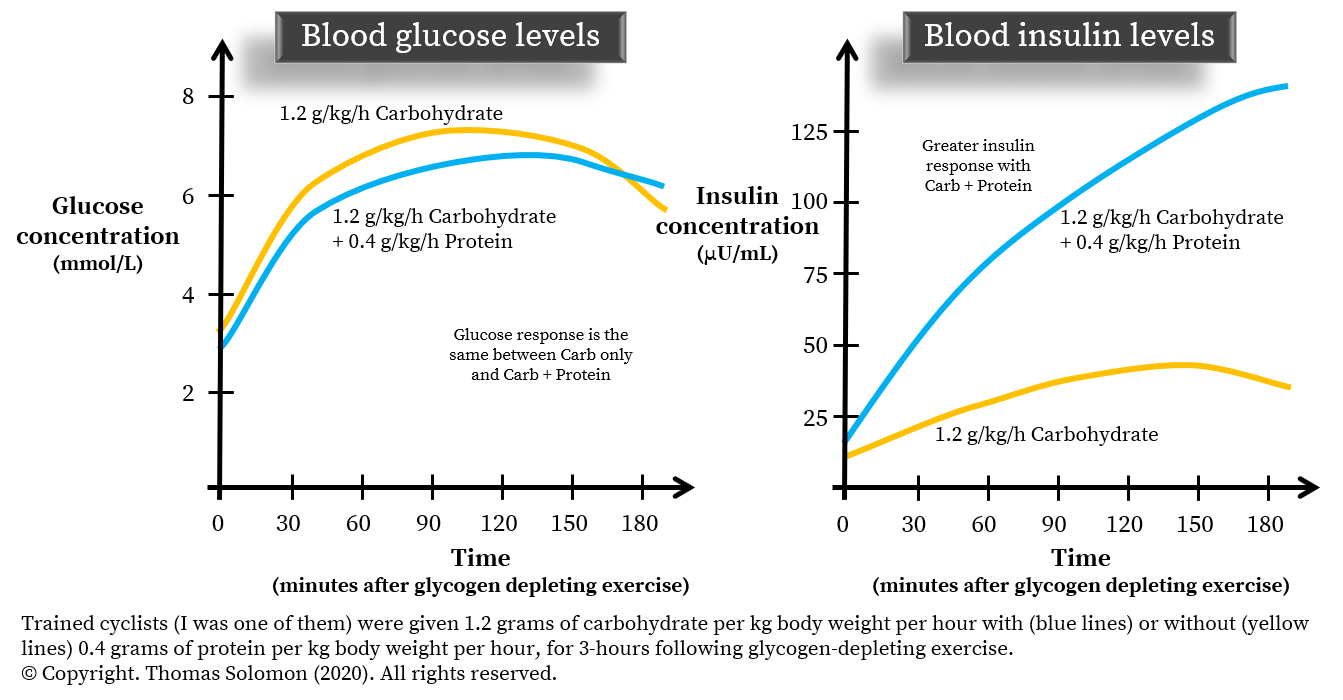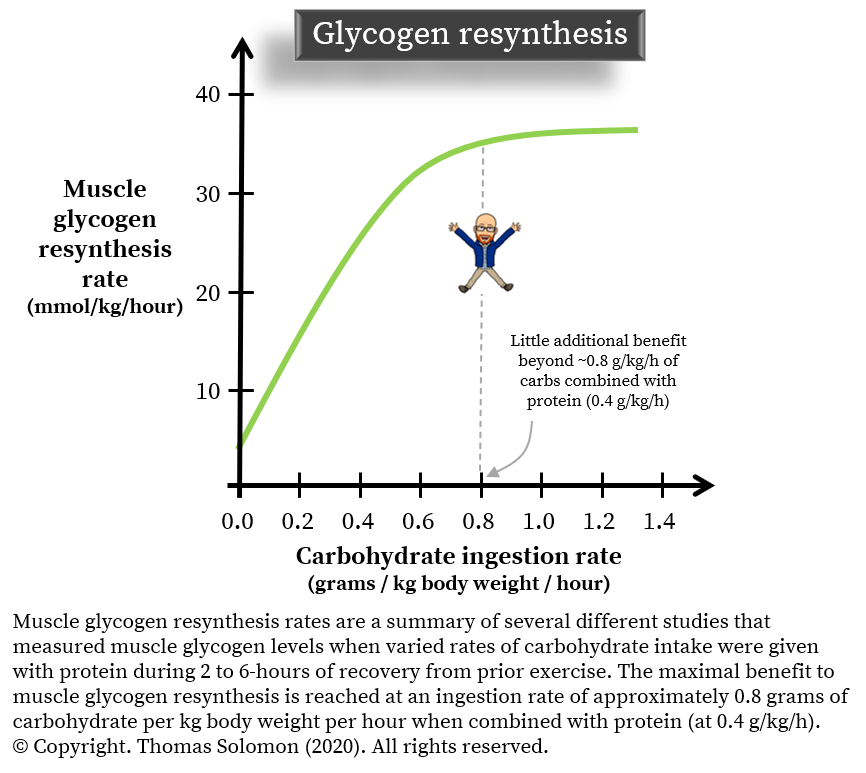Education for runners and endurance athletes. Learn to train smart, run fast, and be strong.
These articles are free.
Please help keep them alive by buying me a beer:
 Buy me a beer.
Buy me a beer.
This article is part of a series:
→ Post-exercise nutrition.
→ Carbohydrates.
→ Protein.
→ Carbs plus protein.
Recovery nutrition for runners and endurance athletes.
→ Healthy eating.→ Post-exercise nutrition.
→ Carbohydrates.
→ Protein.
→ Carbs plus protein.
Carbohydrate plus protein is your recovery super power.
Thomas Solomon PhD.
5th Sept 2020.
Learning to eat to be ready to go again starts with adopting a healthy eating pattern. Then you can integrate sports nutrition, which includes understanding the timing of between-session nutrition and the importance of eating carbohydrate to replenish glycogen and eating protein to increase muscle protein synthesis. To wrap up this delicious nutritional journey to recovery, I will examine the evidence behind the 3-to-1 or 4-to-1 carbohydrate-to-protein ratio that has ubiquitously infected the sports nutrition world...
Reading time ~8-mins (1500-words)
Or listen to the Podcast version.
Or listen to the Podcast version.
Eating carbohydrate combined with protein for recovery boosts glycogen synthesis and the anabolic effect of protein ingestion. How? Firstly, because amino acids from ingested digested protein help sugars (released from ingested carbohydrate) get absorbed in the intestine. Secondly, because the additional insulin response triggered by the influx of sugar and amino acids increases the rate of muscle glucose uptake and protein synthesis while decreasing protein breakdown, compared to when either nutrient is ingested alone. Win-win…
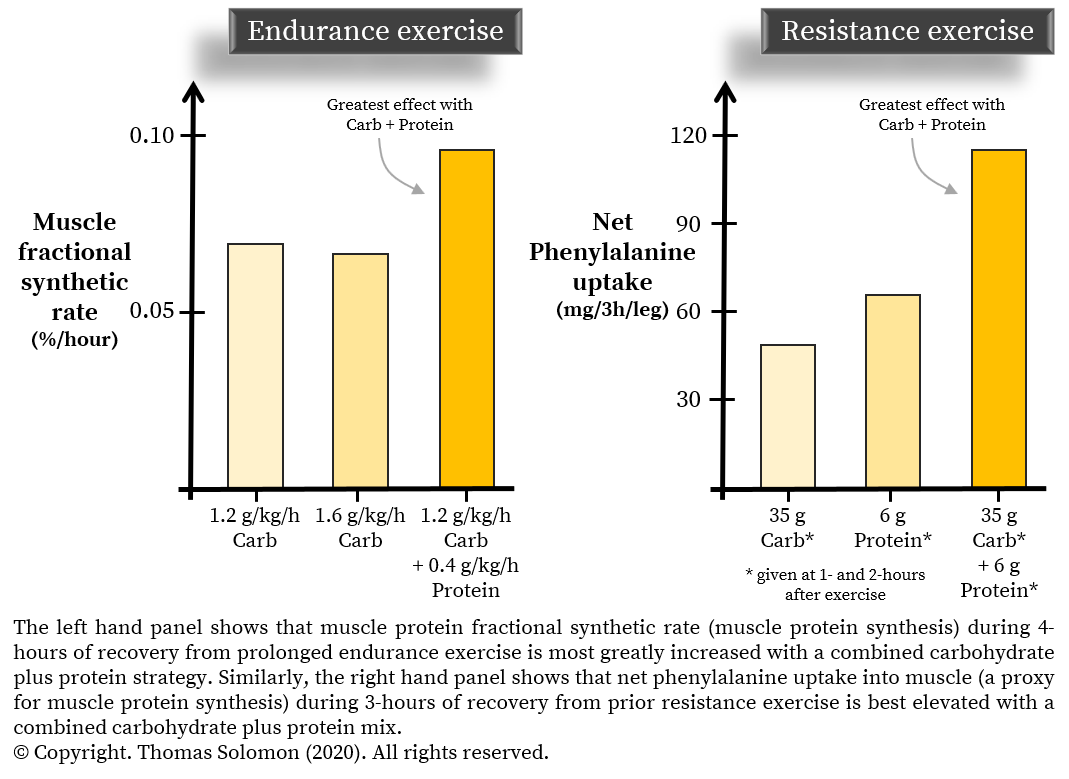
Data extracted from Howarth et al. (2009) J Appl Physiol and Miller et al. (2003) Med Sci Sports Exerc.
 One-serving (44 grams) of Powerbar Recovery Max powder provides
One-serving (44 grams) of Powerbar Recovery Max powder provides
~28 grams of carbohydrate + ~10 grams of protein.
 One 55 gram Powerbar Protein Plus bar provides
One 55 gram Powerbar Protein Plus bar provides
~20 grams of carbohydrate + ~17 grams of protein.
 One-cup (100 grams) of dry oats + ½ cup (125 mL) low-fat milk + 1 medium banana + ½ tbsp honey provides
One-cup (100 grams) of dry oats + ½ cup (125 mL) low-fat milk + 1 medium banana + ½ tbsp honey provides
~95 grams of carbohydrate + ~17 grams of protein.
 One ½-cup (100 grams) of uncooked rice + one ½-cup (100 grams) of tofu + one-cup (90 grams) of chopped broccoli + 1 tbsp soy sauce provides
One ½-cup (100 grams) of uncooked rice + one ½-cup (100 grams) of tofu + one-cup (90 grams) of chopped broccoli + 1 tbsp soy sauce provides
~85 grams of carbohydrate + ~20 grams of protein.
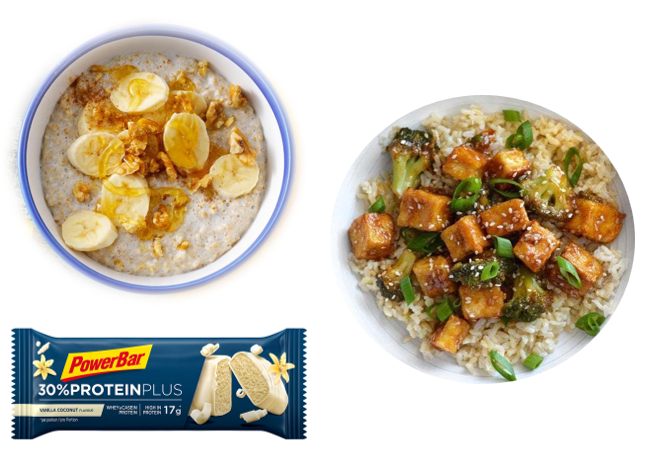
Which of these looks the least tasty and is the least nutrient-dense?
 Always prioritise total daily nutrient intake before worrying about hourly grams per kilogram rates of carbohydrate and protein ingestion.
Always prioritise total daily nutrient intake before worrying about hourly grams per kilogram rates of carbohydrate and protein ingestion.
 Don’t become orthorexic by obsessing over grams and rates. This will create confusion and stress, and you will lose sight of what is important. The suggested doses are evidence-informed guides but not rules — they are based on the average values around which there is large variability. Keep things simple by preparing and eating healthy snacks and meals that provide nutrients. If you find yourself getting nutritionally-stressed, listen to De La Soul.
Don’t become orthorexic by obsessing over grams and rates. This will create confusion and stress, and you will lose sight of what is important. The suggested doses are evidence-informed guides but not rules — they are based on the average values around which there is large variability. Keep things simple by preparing and eating healthy snacks and meals that provide nutrients. If you find yourself getting nutritionally-stressed, listen to De La Soul.
 If your post-exercise urgency is high — i.e. your between-session period is less than 4- to 8-hours — then you would be wise to start consuming carbohydrate- and protein-containing snacks and meals soon after your first work-out.
If your post-exercise urgency is high — i.e. your between-session period is less than 4- to 8-hours — then you would be wise to start consuming carbohydrate- and protein-containing snacks and meals soon after your first work-out.
 If your post-exercise urgency is high and protein is not available, a slightly larger dose of carbohydrate will get you to the same glycogen level as a carbohydrate-plus-protein strategy. This is important because restoration of performance in your second bout of the day is related to muscle glycogen levels, not muscle protein synthesis rates.
If your post-exercise urgency is high and protein is not available, a slightly larger dose of carbohydrate will get you to the same glycogen level as a carbohydrate-plus-protein strategy. This is important because restoration of performance in your second bout of the day is related to muscle glycogen levels, not muscle protein synthesis rates.
 But, if your post-exercise urgency to “recover” is low — i.e. your between-session period is more than 24-hours or even several days — then immediate post-exercise carbohydrate-plus-protein intake is not essential. Just stick to your healthy eating pattern, which will provide you with adequate daily carbohydrate and protein intake that will restore glycogen and keep you in net protein balance in time for your next work-out.
But, if your post-exercise urgency to “recover” is low — i.e. your between-session period is more than 24-hours or even several days — then immediate post-exercise carbohydrate-plus-protein intake is not essential. Just stick to your healthy eating pattern, which will provide you with adequate daily carbohydrate and protein intake that will restore glycogen and keep you in net protein balance in time for your next work-out.
Thanks for joining me for this final “session” on recovery nutrition. For a deeper dive into the effects of adding protein to carbohydrate on the recovery of endurance performance, I can recommend the systematic review, “Effects of Protein in Combination with Carbohydrate Supplements on Acute or Repeat Endurance Exercise Performance”, by Tom McLellan and colleagues. Until next time, keep eating smart to fuel your recovery and boost your training adaptations...
×
![]()
In the early 1990s, it was first shown that in the 2-hours following glycogen-depleting cycling carbohydrate plus protein ingestion further increased insulin secretion and better restored muscle glycogen levels than carbohydrate or protein alone. This additional insulin stimulus and glycogen resynthesis found by combining carbohydrate (0.8 g/kg/h) with protein (0.4 g/kg/h) has been confirmed in subsequent work (here and here). But, there is an important nuance to this synergistic effect—follow up studies have found that increasing the load of carbohydrate in the carbohydrate-only trials (to 1.2 g/kg/h) to match the total caloric intake of carbohydrate-plus-protein trials, increases glycogen resynthesis rates that match those found following carbohydrate-plus-protein strategies. Two further studies (here and here) have also shown that adding protein to this higher carbohydrate load (e.g. adding 0.4 g/kg/h of protein on top of 1.2 g/kg/h of carbohydrate) does not further increase glycogen following low-to moderate-intensity exercise (60-65% VO2max). This suggests there is a limit to the effectiveness of glucose ingestion for rapidly restoring glycogen following an easy-effort session. However, adding protein to the higher carbohydrate load has been shown to boost glycogen resynthesis following high-intensity intervals (cycling at 65-75% VO2max with 15 x 1-min maximal sprints). So, it appears that total caloric intake from carbohydrate and protein is an important consideration for “urgently” getting ready to go again following a tough high-intensity work-out.
×
![]()
Besides a benefit to glycogen replenishment, studies also show that muscle protein synthesis is more greatly increased following both endurance exercise and resistance exercise when carbohydrate and protein are co-ingested (compared to either carbohydrate or protein alone). Similar work examining the effect of carbohydrate plus protein ingestion on exercise-induced muscle damage has found lower post-exercise creatine kinase (a blood marker of muscle damage ) and lower feelings of muscle soreness with more rapid restoration of muscle function in the days following a muscle-damaging eccentric exercise bout (when compared to carbohydrate or protein alone). While it is tempting to speculate that protein has these desired effects because of its “anabolic” muscle protein synthesis powers after exercise, a meta-analysis published in 2014 found that increased muscle protein synthesis is not always found simultaneously with a measurable reduction in muscle damage or restoration of muscle function. As such, the precise mechanisms continue to be unravelled, particularly with recent advancements in methodology that allows protein synthesis to be examined in different “pools” of muscle proteins: namely, myofibrillar and mitochondrial proteins. Furthermore, because the current evidence has largely been derived from using isolated carbohydrates (maltodextrin, fructose, etc) combined with isolated proteins (whey, milk, etc), research scientists are also beginning to use whole foods in these investigations to increase the ecological (or real world) validity and practical applicability of their findings.

×
![]()
Recovery is about restoring performance. For that reason, tests of muscle function are a more valid estimate of recovery than muscle damage, feelings of soreness, muscle glycogen levels, or protein synthesis rates. Reducing damage, lessening soreness, maximising glycogen, and ramping up protein synthesis are important recovery goals but these variables tell us nothing about how your performance is “ready to go again”. In recent posts, I discussed the separate effects of carbohydrate intake and protein intake on subsequent performance outcomes. Research studies have also examined combined carbohydrate-plus-protein ingestion strategies on same-day performance outcomes following an earlier work-out. These studies, which were systematically reviewed in 2013 and meta-analysed in 2020, show better time-to-exhaustion and time-trial endurance performance when carbohydrate plus protein is ingested either during and/or following the earlier bout (compared to carbohydrate alone). Interestingly, the meta-analysis also shows that when the between-session time is short — less than 8-hours — there is little difference between carbohydrate and carbohydrate-plus-protein strategies on subsequent time-to-exhaustion; but, when the recovery time is longer than 8-hours, a huge difference emerges favouring carbohydrate-plus-protein. Furthermore, when post-exercise carbohydrate-only strategies provide the same total calories as carbohydrate-plus-protein strategies, the performance benefits on the subsequent bout are equal.
How can you eat carbohydrate- and protein-containing foods after exercise to get you ready to go again?
Carbohydrate-containing foods are easy to consume as Western culture has filled the shelves and snack foods with it. Protein is a little trickier, but with a little bit of knowledge, it too is easy to obtain. Aiming for healthy choices that provide nutrients should always be the overall goal and distributing your caloric intake across the day is also sensible. As an athlete, distributing your carbohydrate and protein-containing foods across the day also helps you provide adequate levels of nutrients around your sessions. As described in my previous posts on carbohydrate and protein, there are lots of examples of carbohydrate and protein-containing snacks and meals that can be consumed at any meal of the day. For example,~28 grams of carbohydrate + ~10 grams of protein.
~20 grams of carbohydrate + ~17 grams of protein.
~95 grams of carbohydrate + ~17 grams of protein.
~85 grams of carbohydrate + ~20 grams of protein.

×
![]()
Just like there are multiple routes to a healthy eating pattern, there are hundreds of wonderful foods you can combine to meet your carbohydrate and protein requirements and achieve your recovery goals, no matter how “urgent” you need to be ready to go again after your last work-out. Food is brilliant — embrace culinary knowledge and start your gustatory adventure today...
What can you add to your training toolbox?
If your “urgency” for recovery is high, it is recommended to combine carbohydrate and protein in your post-exercise window as soon after your session as is feasible. The evidence to date indicates that consuming 1.2 g/kg/hour of carbohydrate and 0.4 g/kg/hour of protein are optimal dosing strategies for maximizing glycogen resynthesis and protein synthesis rates during the post-exercise window — on average. The numbers, 1.2 and 0.4, are the magic digits that leads to the “3 to 1 carbohydrate:protein ratio” guidance quoted by many sports nutrition product marketing stragies. As it turns out, after all these years, De La Soul was on to something: “Three. That’s the magic number”... But there are some caveats:
Disclaimer: I occasionally mention brands and products but it is important to know that I am not affiliated with, sponsored by, an ambassador for, or receiving advertisement royalties from any brands. I have conducted biomedical research for which I have received research money from publicly-funded national research councils and medical charities, and also from private companies, including Novo Nordisk Foundation, AstraZeneca, Amylin, A.P. Møller Foundation, and Augustinus Foundation. I’ve also consulted for Boost Treadmills and Gu Energy on their research and innovation grant applications and I’ve provided research and science writing services for Examine — some of my articles contain links to information provided by Examine but I do not receive any royalties or bonuses from those links. These companies had no control over the research design, data analysis, or publication outcomes of my work. Any recommendations I make are, and always will be, based on my own views and opinions shaped by the evidence available. My recommendations have never and will never be influenced by affiliations, sponsorships, advertisement royalties, etc. The information I provide is not medical advice. Before making any changes to your habits of daily living based on any information I provide, always ensure it is safe for you to do so and consult your doctor if you are unsure.
If you find value in this free content, please help keep it alive and buy me a beer:
 Buy me a beer.
Buy me a beer.
Share this post on your social media:
Want free exercise science education delivered to your inbox? Join the 100s of other athletes, coaches, students, scientists, & clinicians and sign up here:
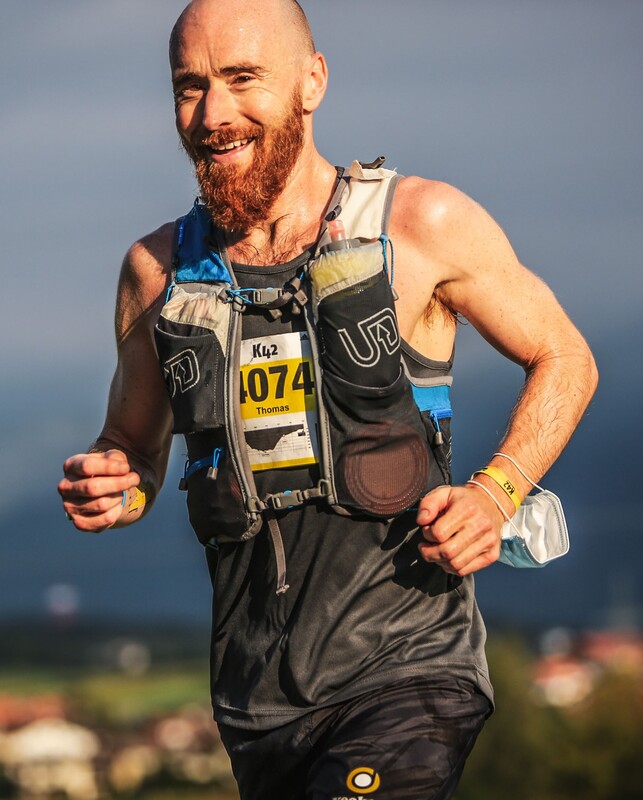
About the author:
I am Thomas Solomon and I'm passionate about relaying accurate and clear scientific information to the masses to help folks meet their fitness and performance goals. I hold a BSc in Biochemistry and a PhD in Exercise Science and am an ACSM-certified Exercise Physiologist and Personal Trainer, a VDOT-certified Distance running coach, and a Registered Nutritionist. Since 2002, I have conducted biomedical research in exercise and nutrition and have taught and led university courses in exercise physiology, nutrition, biochemistry, and molecular medicine. My work is published in over 80 peer-reviewed medical journal publications and I have delivered more than 50 conference presentations & invited talks at universities and medical societies. I have coached and provided training plans for truck-loads of athletes, have competed at a high level in running, cycling, and obstacle course racing, and continue to run, ride, ski, hike, lift, and climb as much as my ageing body will allow. To stay on top of scientific developments, I consult for scientists, participate in journal clubs, peer-review papers for medical journals, and I invest every Friday in reading what new delights have spawned onto PubMed. In my spare time, I hunt for phenomenal mountain views to capture through the lens, boulder problems to solve, and for new craft beers to drink with the goal of sending my gustatory system into a hullabaloo.
Copyright © Thomas Solomon. All rights reserved.
I am Thomas Solomon and I'm passionate about relaying accurate and clear scientific information to the masses to help folks meet their fitness and performance goals. I hold a BSc in Biochemistry and a PhD in Exercise Science and am an ACSM-certified Exercise Physiologist and Personal Trainer, a VDOT-certified Distance running coach, and a Registered Nutritionist. Since 2002, I have conducted biomedical research in exercise and nutrition and have taught and led university courses in exercise physiology, nutrition, biochemistry, and molecular medicine. My work is published in over 80 peer-reviewed medical journal publications and I have delivered more than 50 conference presentations & invited talks at universities and medical societies. I have coached and provided training plans for truck-loads of athletes, have competed at a high level in running, cycling, and obstacle course racing, and continue to run, ride, ski, hike, lift, and climb as much as my ageing body will allow. To stay on top of scientific developments, I consult for scientists, participate in journal clubs, peer-review papers for medical journals, and I invest every Friday in reading what new delights have spawned onto PubMed. In my spare time, I hunt for phenomenal mountain views to capture through the lens, boulder problems to solve, and for new craft beers to drink with the goal of sending my gustatory system into a hullabaloo.
Copyright © Thomas Solomon. All rights reserved.

